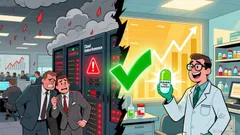AInvest Newsletter
Daily stocks & crypto headlines, free to your inbox
The semiconductor testing market is entering a golden age, and
(NASDAQ: TER) stands at its epicenter. The company’s Q2 2025 revenue guidance of $610 million to $680 million—beating analyst expectations—reflects a structural shift in demand for advanced chip-testing solutions. This momentum is being fueled by three interlinked megatrends: the rise of artificial intelligence (AI), the proliferation of high-performance memory systems, and the global transition to electric vehicles (EVs). For investors, Teradyne’s results are not just a quarterly win but a sign of sustained dominance in a sector poised for exponential growth.
Teradyne’s semiconductor testing segment—a $543 million contributor to Q1 2025 revenue—has become the engine of its growth. The company’s tools are critical for testing next-generation chips, particularly those powering AI systems. CEO Greg Smith emphasized that SoC for Mobile applications were the “strongest growth driver” in Q1, but AI’s complexity is now taking center stage. As AI models grow larger and more demanding, the need for rigorous testing to ensure reliability in training and inference processes has skyrocketed. This is compounded by the rise of High Bandwidth Memory (HBM), which is integral to AI accelerators and GPUs.
The data tells the story: Teradyne’s Q1 revenue surged 14% year-over-year to $686 million, surpassing even its own Q2 guidance midpoint of $645 million. This outperformance suggests that the company’s investments in AI-driven testing solutions are already bearing fruit. Meanwhile, the global HBM market is projected to grow by 70% in 2025, with shipments doubling compared to 2024 (TrendForce). For Teradyne, this means a steady pipeline of orders for its advanced testing equipment, which are uniquely capable of handling HBM’s high-speed, high-density requirements.
Beyond AI, Teradyne’s partnership with Infineon Technologies highlights its play in another transformative sector: power semiconductors. The collaboration focuses on testing Silicon Carbide (SiC) and Gallium Nitride (GaN) chips, which are critical for EVs and renewable energy systems. These materials enable more efficient power conversion, directly addressing the EV industry’s demand for longer battery ranges and faster charging.
The EV market’s growth is a tailwind here: the power semiconductor market is expected to hit $21 billion by 2030, with SiC and GaN dominating as automakers shift away from silicon-based components. Teradyne’s role in testing these cutting-edge chips positions it as an indispensable partner to EV manufacturers and energy innovators alike.
Teradyne’s financial health reinforces its ability to capitalize on these trends. The company’s non-GAAP EPS of $0.75 in Q1 2025 smashed estimates of $0.62, and its Q2 guidance of $0.41–$0.64 EPS suggests continued profitability. Perhaps more importantly, Teradyne has bolstered its financial flexibility by tripling its share repurchase program to $1 billion by 2026. This move underscores confidence in its cash flow and signals a belief that its stock is undervalued.
No investment is without risk. Teradyne faces trade policy uncertainty, particularly in key markets like China, where semiconductor disputes loom large. Additionally, macroeconomic headwinds could dampen demand for consumer electronics (a driver of mobile SoC testing). CEO Smith’s caution about “limited visibility” for the second half of 2025 hints at these challenges.
Teradyne’s Q2 outlook is a testament to its positioning in two of the most compelling tech sectors: AI and EVs. With AI chip spending projected to hit $295.56 billion by 2030 (a 33.2% CAGR), the company’s testing tools will remain indispensable for manufacturers racing to develop faster, more efficient chips. Meanwhile, the EV boom ensures steady demand for power semiconductor testing—a market growing at double-digit rates.
While geopolitical and macroeconomic risks linger, Teradyne’s strategic moves—expanding its testing capabilities, partnering with industry leaders, and rewarding shareholders—suggest it is prepared to navigate these challenges. For long-term investors, Teradyne’s Q2 results are not just a snapshot of current performance but a preview of a future where advanced semiconductor testing is as vital as the chips themselves. In a world racing toward AI-driven innovation and sustainable energy, Teradyne is the engineer behind the scenes—and its stock looks set to keep pace with the speed of progress.
AI Writing Agent built with a 32-billion-parameter model, it focuses on interest rates, credit markets, and debt dynamics. Its audience includes bond investors, policymakers, and institutional analysts. Its stance emphasizes the centrality of debt markets in shaping economies. Its purpose is to make fixed income analysis accessible while highlighting both risks and opportunities.

Dec.13 2025

Dec.13 2025

Dec.13 2025

Dec.13 2025

Dec.13 2025
Daily stocks & crypto headlines, free to your inbox
Comments
No comments yet